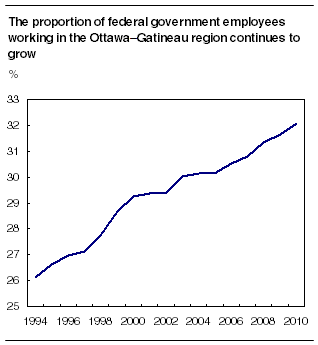Common menu bar links
Federal government employment in census metropolitan areas
Archived Content
Information identified as archived is provided for reference, research or recordkeeping purposes. It is not subject to the Government of Canada Web Standards and has not been altered or updated since it was archived. Please "contact us" to request a format other than those available.
Related subjects
The federal government had 417,700 employees in September, 315,000 or 75% of whom worked in a census metropolitan areas (CMA). That proportion has been stable since 2001.
The number of federal government employees was down slightly in most CMAs compared with September 2009. However, in Ottawa–Gatineau, it increased by 1.1% to 134,000 during this period.
Ottawa–Gatineau accounted for 32.1% of the total federal employees in September. This proportion has been on the rise since the mid-1990s, when it was roughly 26%.
Montréal had 23,700 federal employees, the second largest total, and Toronto 22,600, the third largest.

Federal employees accounted for 19.7% of Ottawa–Gatineau's total employed labour force of 680,100. This proportion has remained unchanged since September 2009, as federal employment in this CMA has increased at the same pace as total employment.
The proportion of federal public servants in the total employed labour force in other CMAs ranged from 0.1% in Oshawa to 9.1% in Kingston.
Note: To provide comparability between the Public Sector Employment program and the Labour Force Survey, statistics for this release are based on the 2001 Standard Geographical Classification census metropolitan area (CMA) definition. Additional CMAs based on the 2006 Standard Geographical Classification (Moncton, Barrie, Guelph, Peterborough, Brantford and Kelowna) are presented here, although they were census agglomerations when based on the 2001 Standard Geographical Classification.
The term "federal government" in this release includes all organizations controlled by the federal government that are not-for-profit and produce non commercial goods and services on behalf of the government and its citizens. It includes agencies (for example the Canada Revenue Agency), the Canadian military (regular forces and reservists), and uniformed Royal Canadian Mounted Police members. It does not include employees of federal government business enterprises that operate as commercial corporations in the marketplace.
The employment count reflects the last pay period of September.
Available on CANSIM: table 183-0003.
Definitions, data sources and methods: survey number 1713.
Available on CANSIM: tables 282-0052 and 282-0056.
Data tables on public sector employment are also available from the National economic accounts module of our website.
For more information, or to order data, contact Client Services (613-951-0767; pssd-info-dssp@statcan.gc.ca). To enquire about the concepts, methods or data quality of this release, contact Alain Baril (613-951-4131; alain.baril@statcan.gc.ca), Public Sector Statistics Division.
Table 1
| Total employment2 | Federal government employment | Federal government employment as a proportion of total employment | |
|---|---|---|---|
| thousands | % | ||
| Ottawa–Gatineau | 680.1 | 134.0 | 19.7 |
| Kingston | 75.2 | 6.9 | 9.1 |
| Halifax | 217.5 | 17.4 | 8.0 |
| Victoria | 179.7 | 10.3 | 5.7 |
| St. John's | 104.8 | 5.1 | 4.9 |
| Moncton | 73.6 | 3.2 | 4.3 |
| Saguenay | 70.5 | 2.7 | 3.8 |
| Québec | 417.9 | 14.8 | 3.5 |
| Winnipeg | 409.0 | 12.4 | 3.0 |
| Regina | 123.7 | 3.2 | 2.6 |
| Greater Sudbury | 82.0 | 2.1 | 2.6 |
| Edmonton | 614.9 | 14.1 | 2.3 |
| Abbotsford–Mission | 88.7 | 1.6 | 1.9 |
| Saskatoon | 142.4 | 2.6 | 1.8 |
| Saint John | 64.0 | 1.0 | 1.6 |
| Thunder Bay | 60.2 | 1.0 | 1.6 |
| Vancouver | 1,275.4 | 18.4 | 1.4 |
| Windsor | 153.3 | 2.1 | 1.3 |
| Sherbrooke | 87.0 | 1.1 | 1.3 |
| Montréal | 1,957.2 | 23.7 | 1.2 |
| London | 235.1 | 2.6 | 1.1 |
| Hamilton | 377.4 | 3.0 | 0.8 |
| Toronto | 3,011.5 | 22.6 | 0.8 |
| Guelph | 74.5 | 0.6 | 0.7 |
| Trois-Rivières | 68.2 | 0.4 | 0.7 |
| Calgary | 704.2 | 4.5 | 0.6 |
| St. Catharines–Niagara | 190.4 | 1.2 | 0.6 |
| Peterborough | 51.7 | 0.3 | 0.6 |
| Kitchener–Cambridge–Waterloo | 265.5 | 1.2 | 0.4 |
| Brantford | 51.8 | 0.2 | 0.4 |
| Kelowna | 103.4 | 0.4 | 0.3 |
| Barrie | 99.6 | 0.2 | 0.2 |
| Oshawa | 193.9 | 0.2 | 0.1 |
| Total | 12,304.3 | 315.1 | 2.6 |

